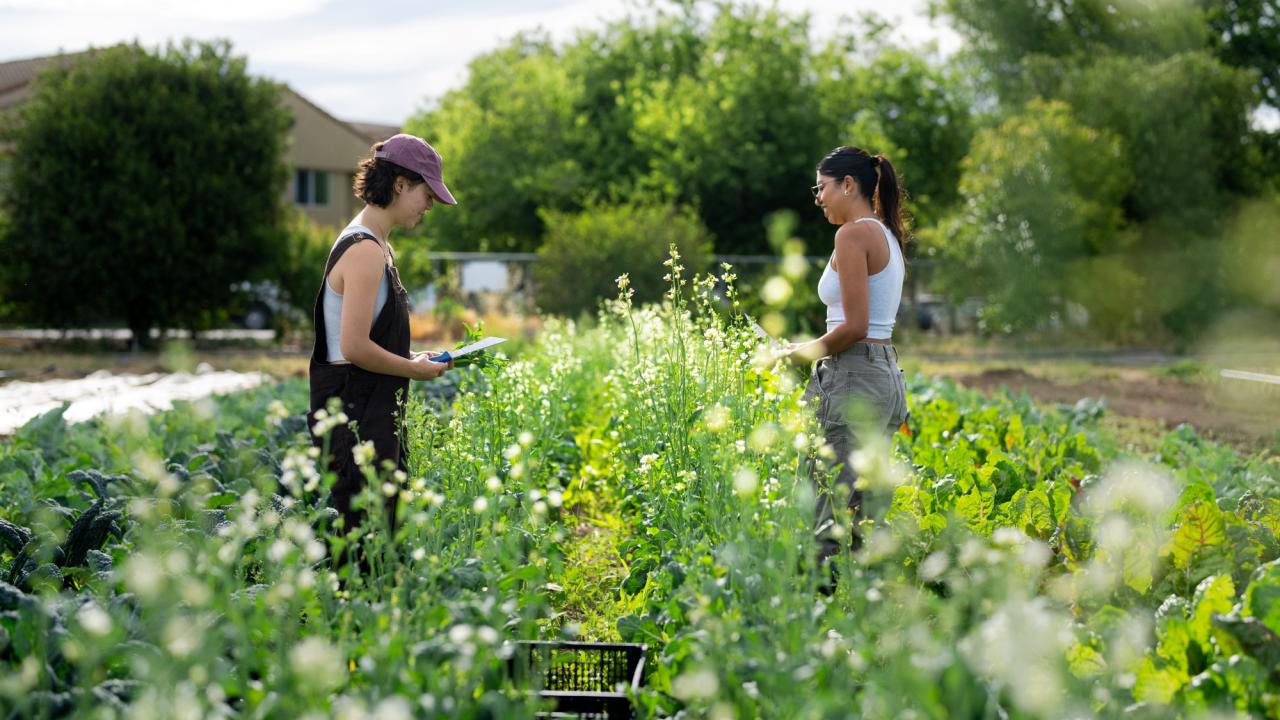
The Buzz About Pollinators
Supporting Spring’s Hardest Workers at the Student Farm
Spring at the Student Farm is something special.
The air feels fresher, the soil softer, and everywhere you look, something new is sprouting or blooming. It’s the kind of season that makes you slow down and notice the small things—like the bees hovering over cilantro flowers, or a butterfly weaving through the garden rows. These aren’t just pretty signs of spring. They’re pollinators, and they’re essential to everything we do out here.
Pollinators—bees, butterflies, hummingbirds, beetles, moths, flies, and even bats—are the bridge between flowers and fruit. Over 75% of all flowering plant species, including most of the crops we grow, depend on them to reproduce. That means no squash, no tomatoes, no peppers, no strawberries—unless something (or someone) transfers pollen from one flower to another. These little creatures are vital to our food system, and yet, their populations are in serious decline due to habitat loss, pesticide exposure, climate change, and disease.
Pollinators—bees, butterflies, hummingbirds, beetles, moths, flies, and even bats—are the bridge between flowers and fruit.
At the UC Davis Student Farm, we take this seriously. We’re not just growing food—we’re caring for an ecosystem. Supporting pollinators is a big part of that work. Here are some of the practices we use to encourage and protect pollinators on the farm:
Maintaining habitat diversity: We plant a wide range of flowers and herbs that bloom at different times of the year to ensure pollinators have a steady food supply from early spring to late fall. You’ll find calendula, alyssum, borage, and flowering brassicas blooming between our crop rows.
Leaving things a little wild: Some of the best pollinator habitats are the less “tidy” ones. We leave parts of the farm undisturbed, where native grasses and flowering weeds like dandelion and clover can thrive. These provide food and nesting spots for native bees and insects.
Avoiding harmful chemicals: We never use synthetic pesticides or herbicides in our growing areas. Even organic-approved sprays are used with extreme care and only when absolutely necessary. This protects both pollinators and the soil microbiome.
Incorporating native plants: In areas like the hedgerows and borders, we’ve planted native species like narrowleaf milkweed, yarrow, California buckwheat, and toyon. Native pollinators co-evolved with these plants and rely on them for survival.
Using cover crops strategically: Crops like vetch, clover, and phacelia don’t just fix nitrogen in the soil—they also bloom with small, nectar-rich flowers that attract bees and hoverflies. We often let them flower before turning them in.
Education and outreach: Through farm tours, field days, and conversations with volunteers, we share what we know about pollinators and encourage others to plant pollinator-friendly gardens, even in small spaces.
If you live in Davis or the surrounding area and want to support pollinators at home, you don’t need a whole farm. A few pots or a garden bed with the right plants can go a long way. Some great options include:
California poppy – Easy to grow, drought-tolerant, and loved by bees.
Narrowleaf milkweed – Crucial for monarch butterflies.
Yarrow – Long-lasting blooms and great for beneficial insects.
Cleveland sage – Fragrant and attractive to hummingbirds and native bees.
Lavender and rosemary – Both are Mediterranean herbs that thrive in our climate and attract a wide range of pollinators.
Sunflowers – Tall, cheerful, and an abundant source of pollen and nectar.
The best thing you can do is plant a variety—choose different shapes, colors, and bloom times. And if you can, go native. Native plants are adapted to local soil and climate, which makes them easier to care for and better suited to support native pollinators.
Spring is a season of growth and return. As student farmers, we feel the rhythm of the land waking up again—and with it, the hum of pollinators doing what they’ve done for thousands of years. Tending to them is one of the ways we tend to the future.
So the next time you see a bee hovering near a flower, take a moment to watch. That tiny moment is part of a much bigger cycle, one we’re lucky to be part of—and one we need to protect.